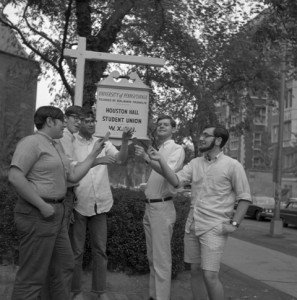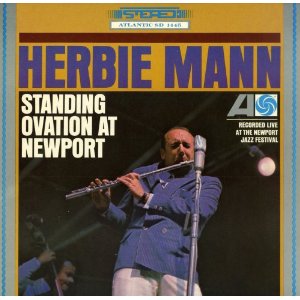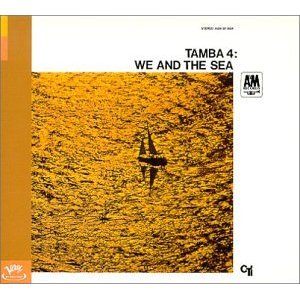Sharing: Comin’ Home, Baby and The Hill (O Morro)
Theme Songs Page |Previous Theme Song | Next Theme Song
Sharing
Comin’ Home Baby, by Ben Tucker, performed by Herbie Mann (1966), encountered 1967
Buy it here |View it here (earlier performance)
The Hill (O Morro), by Antonio Carlos Jobim and Vinicius deMoraes, performed by The Tamba 4 (1968), encountered 1968
One of the great things about the coming-together of college classes is simply this: The records get shared. Now I know I’m dating myself by saying it that way. And these days it’s equally dating to say “the tapes get shared” or “the CDs get shared.” But isn’t this slightly anachronistic phrase the simplest, most generic way to say it? Would you prefer “the music files get shared” or “the playlists get shared” or “the downloads get shared”? Each phrase has something unhelpfully limiting about it. Choose your own phrasing, then, but then move on and think about my point, which has probably been valid one way or another since collegians first started rooming together in the Middle Ages and teaching each other ditties on the lute and the recorder.
No one, particularly in the space of the 18 years they’ve taken to ready themselves for college, gets to experience or learn to treasure all that the vast trove of music has to offer. As the ancients put it, Ars longa, vita brevis. But pool a bunch of brief 18-year stretches of musical experience and you’ve got something collective, ready to pool. Put a bunch of 18 year-olds in one space and the pooling begins.
What I Was Hearing
All over my dorm I was hearing new things, or hearing old things in a new way. Take my roommate Billy. He was the one who first made me aware of Burt Bacharach as an auteur and performer in his own right.[1] I first heard Wives and Lovers on Billy’s Reach Out LP (1967).[2] Billy also focused me on the Mamas and the Papas, who had simply been part of the Top 40 wallpaper to me before that. A bright and earnest young man from down the hall made me listen to the Byrds beyond their big hits. And I would hang in the record stores, especially a place called Jerry’s, on Walnut Street,[3] and just note what the sophisticated kids were buying: Jimi Hendrix, Jethro Tull, Cream, Dylan, Big Brother, the A Man and a Woman soundtrack.
One of the most dramatic discoveries for me was courtesy of a guy a dorm block or two over named Steve Morris. I don’t remember how we met, but I can guess. Steve played the flute really, really well. I’m guessing I heard the sound of his instrument coming from his window, then traced it to the dorm room it came from, and, if memory serves, invited myself into his room. I not only heard him play, but listened while he put on one of his records, Herbie Mann’s incendiary performance of Comin’ Home, Baby at the 1965 Newport Jazz Festival. This would have been close to my introduction to jazz flute. My one previous experience had been two or three years before listening to the college-age son of my parents’ friends, playing Swingin’ Shepherd Blues.[4] I’d liked that a lot. And here, with Herbie Mann’s record, I was suddenly happening upon the Mother Lode.
Though Steve was not destined to be a great friend, he was palpably marked to be a musician of some consequence,[5] and if he was excited about Comin’ Home, Baby, it was an endorsement of my own instant rapture.
I can describe it, but you really have to hear it to believe it. This was the nearly 11-minute capstone of Mann’s July 3, 1965 set at that edition of the Festival. Mann rocks out backed by vibes, two trombones, Chick Corea on piano, drums and conga drums, and the composer, Ben Tucker, on bass. First Mann solos, zooming around like a mosquito, making this simple blues pattern sparkle with all kinds of colors, with just Tucker giving rhythm and the hint of a chord pattern for about three minutes, followed by a couple of minutes of solos from the sidemen, followed by more of Mann. The crowd goes wild, and Mann leaves the stage. Per the George T. Simon liner notes: “Herbie had already left the stage, with no idea of returning, when producer George Wein grabbed him and yelled, ‘Get up there again! Hit ‘em again!’” I’m not sure that this story isn’t a bit of showbiz hokum (what star leaves the stage after a set that kills without planning to provide an encore?), but it captures the intensity of the moment.
What I Was Sharing
People shared with me, I shared with them. I can remember proselytizing for my own discovery, the Tamba 4, whose album We and the Sea was, so far as I can recall, something I just picked up in the campus bookstore. Probably what attracted me was the cover, a gorgeous thing in what I subsequently discovered was the trade dress of the CTI “imprint” within A&M Records: big photos wrapping around from front to back covers, leaving room for only one commensurately-sized photo of the performer(s) on the back. I’m not sure what this particular cover photo, a sailboat captured from above, adrift on a golden sea,[6] had to do with the music, but of course when I got the shrink wrap off and could listen to the record itself, it stood on its own merits.
And believe me, it was meritorious. The big number is Jobim and deMoraes’ The Hill (O Morro), in the original Portuguese (I am told) an evocation of Rio’s hillside favela slums (though you barely get a hint of that in the standard English translation). I don’t think there was any intention on Tamba 4’s part to use the jazz setting of this song to convey any particular message. Instead, it is to blend some distinctly highbrow, north-of-the-border piano styling with Jobim’s plaintive southern hemisphere melody. The liner notes mention Ravel, Debussy, and Gershwin; I think those are very apt comparisons. Luiz Eça, the keyboard man, builds an astonishing set of classically-inflected variations on Jobim’s line. The most astonishing moment of all comes at about 4:45 into this nearly 8-minute song, when Eça, slowly ditching the accompaniment of the other three musicians, sneaks his way up to a pianissimo E three octaves above middle C, and then slides down with a sudden vertiginous drop, as if going down a roller coaster, with a driving beat in the left hand and a silky tour up and down and up and down the treble clef with the right. You think a little bit of Art Tatum, it’s so ornate, but as with Tatum at his best, the show-offiness is all in support of real thematic variations.
I had never heard anything like this at all. I knew (though I wouldn’t have used this vocabulary for it at the time) that it was at once sophisticated and of the vernacular. And it was a bit of my own unique taste that I brought to the great record sampling. I remember guys standing in the door of my dorm room chatting while I was playing these songs. Sometimes they would pay attention, sometimes not. But my dorm room had a certain flavor, of which this was a part (along with a picture of David Hemmings in Blow-Up and a poster some friend at the Daily Pennsylvanian copied for me in the photo lab: a hippie-ish young man holding a burning piece of paper (evidently meant to be a draft card), with the legend at the bottom: FUCK THE DRAFT).[7] I was adding my little bits to the cultural stew, and taking my little bits out.
[1] Having previously been familiar with his tunes in the hands of others, like Walk on By, discussed in an earlier posting, but not so much that he was the common thread.
[2] Yes, I know full well that the Hal David lyrics are jaw-droppingly old-fashioned where it comes to gender roles within a marriage. No one would write that song today. But it’s still beautiful and wistful within its own frame of reference. Definitely Don Draper music.
[3] Don’t think this was a relative of the Jerry’s vinyl emporium in Pittsburgh, which has, per its website, only been in business for “33-1/3 years,” which wouldn’t make it reach back far enough – although that number is obviously a joke.
[4] So far as I can determine, Swingin’ Shepherd was originated by Moe Koffman, one of its composers, in a 1958 hit record. It was covered by a lot of other people, including Ella Fitzgerald, before my new idol Herbie Mann got to it in a 1967 LP, The Beat Goes On.
[5] He was one of the founding members of Wax, a Philadelphia band that was a name to conjure with for a while.
[6] For some reason in more recent reissues, the gold has been turned orange. I don’t know what that’s all about.
[7] A sentiment I’ve revisited and explored more respectfully, but to the same conclusion, elsewhere in this blog. At the end of the year, in a pale and simultaneously intentionally and unintentionally ironic imitation of the draft card burnings which were going on around the country, I and my friends burned our Freshman Commons cards.
Copyright (c) Jack L. B. Gohn

